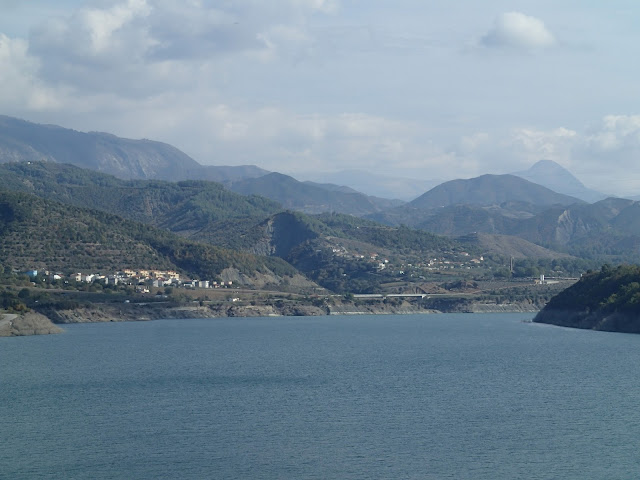 |
| Spercheios spirlin in late Spring (sporting reproductive colours) - Photo by D. Koutsogiannopoulos. |
Oct 25th 2017
The Spercheios river was known to be important for biodiversity since Alexander Stephanidis collected fishes there. A crossroads between the
dry and biogeographically isolated Western Aegean river basins and the species-rich North
(Macedonia-Thessaly Ecoregion). Stephanidis described a new 'subspecies' of Sprilin from
here and from the adjacent Thessalian Pinios (Alburnoides spp thessalicus he called them both). He did not see morphological
differences between the two rivers' fishes - their morphological differences
are quite microscopic (he published in 1950...). What he could not know at the
time is that these similar-looking fishes are so different...genetically.
Despite very similar overall looks, when compared to other European Alburnoides species the spirlins from the Spercheios differ remarkably at the genetic level from all other spirlin species. Genetic divergence to other spirlin species ranges from 7.3 to 8.8% (based on cytochrome b nucleotide sequences). An outstanding difference.
In our recent paper in Biologia we described the species from Sperchios as new to science: Alburnoides
economoui. We also redefine the spirlin species of the Macedonia-Thessaly Freshwater Ecoregion as Alburnoides thessalicus (Stephanidis
1950)- Thessalian spirlin. This presumably includes fishes of the Axios / Vardar, also within FYR Macedonia
(so the Thessalian fishes are not exclusive endemic to Greece). Morphologically there are really only very slight differences and a lot of "character overlap" (various specific body part sizes and shapes show variation). Spercheios spirlin has a near complete scale-less keel and a slightly humped distinction behind the head, and some other minute character traits - all need expert measurment to distinguised the species. The identification traits show quite well in adults, not usually in young fishes.
Finally, our paper shows that more work is needed to complete the naming of Greece's fishes (problems in the Epirus/Albanian spirlins persist). Also we show
for the first time that Alburnoides
bipunctatus (the European spirlin), the species' nominate race of the Danube, really does not exist in Greece.
Why did we name it A. economoui?
We thought of various names. For example,
Leonidas, the famous Spartan who fought the Persians near the Sperchios river
in 480 BC. But Alcibiades N. Economou soon came unanimously to mind... A man who has done so
much for Greek ichthyology and for river conservation and for the Spercheios, he should be remembered. Alcibiades
N. Economou, known as Alkis to friends, is one of the most important marine
Ichthyologists to have worked in freshwater fish conservation in Greece... Since
the mid '90s he helped catalogue and explore inland waters for fishes. One of the
most important works he and Roberta Barbieri (et al.) did was an inventory of
all water bodies in the Peloponnese and the West of Greece (Economou et al.
1999); this is a remarkable unpublished report providing amazing data on the natural history of Greece's endemics. Alkis also worked hard for the Sperchios basin biodiversity since the
late '90s (with another intrepid explorer, Dr. Charalambos
Daoulas). They made the Sperchios famous for its rare fishes - especially
focusing on the Greek Stickleback (in fact they did the first conservation
translocation of a population of sticklebacks that was successful). Alkis's
research style is deep, long-term and holistically inquisitive. He
has been concerned with biological conservation since his marine work (since the late '70s); and especially his freshwater career has helped many of us in Greece
focus on the conservation relevance of our work. For me, Alkis
has been especially important in helping Greece develop in the
application of the Water Framework
Directive (WFD), especially scientific aspects of "reference conditions" as outlined
in one of his seminal reports (Economou 2003). During the last 15 years he has
spearheaded important fish-based techniques for WFD R&D in Greece (e.g. Economou
et al. 2016). This includes no less than 7 attempts at bioassessment index building and the
recent successful intercallibration of our model-based index (Tachos et al.
2016; Zogaris et al.- in review). Alkis is a deeply collaborative person and has worked with almost all Greek
inland water ichthyologists, especially during the important projects to assess
the conservation status of Greece's fishes and the publication of our first river basin species lists (Economou et al. 2007) and our recent
annotated fish list (Barbieri et al. 2015). He also was the first Director of
our new institute amalgam during hard times in the beginning of the recent Greek
Crisis. He is an exemplary leader.
Please read our paper:
(For references in the text above see our freshwater fish checklist, Barbieri et al. 2015)
 |
Spercheios Spirlin, Male, (original holotype specimen, photographed at HCMR lab) - Photo by R. Barbieri. |
 |
Thessalian Spirlin, Male, (fresher specimen, photographed at HCMR lab) - Photo by R. Barbieri. |



















































